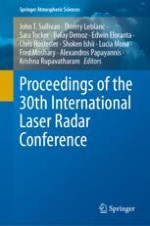This volume presents papers from the biennial International Laser Radar Conference (ILRC), the world’s leading event in the field of atmospheric research using lidar. With growing environmental concerns to address such as air quality deterioration, stratospheric ozone depletion, extreme weather events, and changing climate, the lidar technique has never been as critical as it is today to monitor, alert, and help solve current and emerging problems of this century. The 30th occurrence of the ILRC unveils many of the newest results and discoveries in atmospheric science and laser remote sensing technology. The 30th ILRC conference program included all contemporary ILRC themes, leveraging on both the past events’ legacy and the latest advances in lidar technologies and scientific discoveries, with participation by young scientists particularly encouraged.
This proceedings volume includes a compilation of cutting-edge research on the following themes: new lidar techniques and methodologies; measurement of clouds and aerosol properties; atmospheric temperature, wind, turbulence, and waves; atmospheric boundary layer processes and their role in air quality and climate; greenhouse gases, tracers, and transport in the free troposphere and above; the upper mesosphere and lower thermosphere; synergistic use of multiple instruments and techniques, networks and campaigns; model validation and data assimilation using lidar measurements; space-borne lidar missions, instruments and science; ocean lidar instrumentation, techniques, and retrievals; and past, present and future synergy of heterodyne and direct detection lidar applications. In addition, special sessions celebrated 50 years of lidar atmospheric observations since the first ILRC, comprising review talks followed by a plenary discussion on anticipated future directions.
